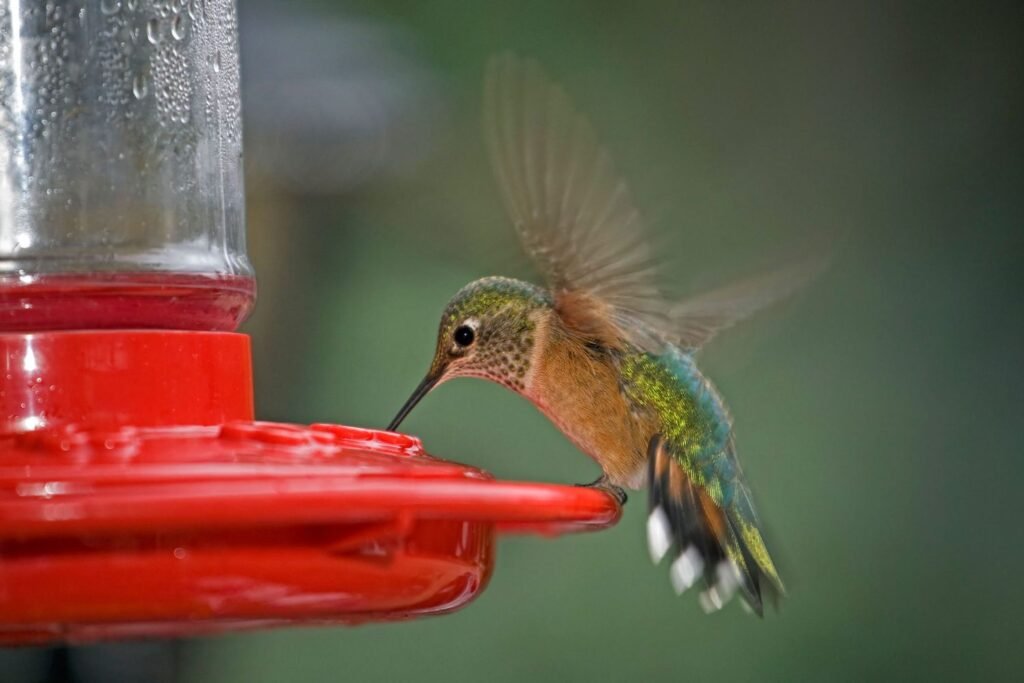Hummingbirds, with their iridescent feathers and rapid wing beats, are among nature’s most fascinating creatures. Attracting these aerial acrobats to your garden not only adds a splash of color and vibrancy but also provides an opportunity to observe their behaviors up close. One of the best ways to attract hummingbirds is by providing them with a steady supply of food. This guide will walk you through the simple, yet rewarding process of making your own hummingbird food, ensuring your garden becomes a preferred stopover for these tiny birds.
Understanding Hummingbird Nutrition
Before diving into the recipe, it’s essential to understand what hummingbirds need from their diet. In the wild, hummingbirds feed on nectar from flowers, which provides them with the sugar they need for energy. Additionally, they consume small insects and spiders for protein, essential for muscle maintenance and growth. The homemade food we can provide mimics the nectar they naturally seek.
The Simple Recipe
Making hummingbird food is surprisingly simple and requires only two ingredients: sugar and water. The ideal ratio is 1 part white, granulated sugar to 4 parts water. This concentration closely resembles the sugar content of natural flower nectar and is safe for hummingbirds.
Ingredients and Supplies:
- 1 cup of white granulated sugar
- 4 cups of water
- A medium saucepan
- A spoon for stirring
- A funnel (optional)
- A clean feeder
Instructions:
- Boil the Water: Start by bringing the water to a boil. This step is crucial as it helps to eliminate any impurities in the water, ensuring it’s safe for the hummingbirds to consume.
- Dissolve the Sugar: Once the water is boiling, add the sugar and stir until it is completely dissolved. This process should be done off the heat to prevent caramelization of the sugar, which could be harmful to the birds.
- Cool the Solution: Allow the sugar-water mixture to cool completely. This is an essential step to ensure that it’s at a safe temperature for the hummingbirds and to prevent fermentation that could occur if the solution is stored while still warm.
- Fill the Feeder: Using a funnel, pour the cooled sugar water into your clean hummingbird feeder. Any excess can be stored in the refrigerator for up to two weeks.
- Hang the Feeder: Place your feeder outside in a shaded area to prevent the solution from spoiling too quickly. The shade also makes it more comfortable for hummingbirds to feed without being exposed to direct sunlight.
Feeder Maintenance and Placement
Keeping It Clean
Hummingbird feeders should be cleaned and refilled every two to five days, depending on the weather. In hotter temperatures, it’s advisable to clean them more frequently to prevent mold and fermentation. Use hot water and a brush specifically designed for feeders to ensure they are thoroughly cleaned. Avoid using soap or detergents, as these can leave harmful residues.
Ideal Placement
For the best results, place your feeder near colorful flowers that naturally attract hummingbirds. This not only provides them with additional natural nectar sources but also encourages them to explore your feeder. Ensure the feeder is hung at a height that prevents access by predators, including cats, and is easily visible to passing hummingbirds.
The Importance of Patience
Attracting hummingbirds to a new feeder takes time and patience. It may take several weeks for hummingbirds to discover your feeder, but once they do, they are likely to return regularly. To increase your chances of attracting them, you can tie red ribbons around the feeder or nearby to catch their eye, as hummingbirds are drawn to bright colors, especially red.
Additional Tips for Attracting Hummingbirds
Aside from providing homemade nectar, there are other ways to make your garden more inviting to hummingbirds:
- Plant Native Flowers: Cultivating a variety of native flowers that bloom at different times of the year can provide natural nectar sources for hummingbirds.
- Provide Perches: Hummingbirds need places to rest and watch for predators, so having trees or shrubbery near your feeder can make your garden more attractive.
- Water Sources: Including a birdbath or a misting fountain can provide hummingbirds with a place to bathe and play, which they find irresistible.
Conclusion
Creating homemade hummingbird food is a simple and satisfying way to attract these beautiful birds to your garden. By following the recipe and maintenance tips provided, you can ensure a safe and nutritious food source for hummingbirds, encouraging them to visit your garden throughout the season. Remember, the key to success is patience and consistency in providing a clean, reliable food source. With time, your garden will become a haven for hummingbirds, providing endless opportunities to observe these fascinating creatures up close.
FAQs on Making Hummingbird Food
1. Can I use honey, brown sugar, or artificial sweeteners instead of white sugar?
No, it’s important to use plain white granulated sugar. Honey can ferment and promote harmful bacterial growth. Brown sugar contains molasses, which can be harmful to hummingbirds. Artificial sweeteners do not provide the calories hummingbirds need to sustain their high energy levels.
2. Why do I need to boil the water?
Boiling the water serves two primary purposes: it helps to purify the water by killing any bacteria or microorganisms, and it makes it easier to dissolve the sugar completely, ensuring a smooth solution that mimics natural nectar.
3. How often should I change the hummingbird food in the feeder?
You should replace the hummingbird food and clean the feeder every two to five days, depending on the weather. In hotter climates, the nectar can spoil more quickly, so it’s advisable to change it more frequently.

